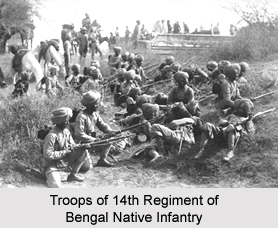 The 14th Regiment of Bengal Native Infantry was a former British Indian infantry battalion of the East India Company, which existed from the year 1846 to 1922. The unit was included as a part of the Bengal Native Infantry, which consisted of various regiments that served under Bengal Army during wartime. The Army of the Bengal province was the military force of Bengal Presidency and was one of the main Presidency Armies in British India. During the Great Revolt of 1857, most of the troops of the Bengal Native Infantry participated in the revolt against the Honourable British East India Company. Later it became a part of the United British Indian Army. King Edward VII acted as the Colonel-in-Chief of the battalion in 1904. The battalion was also a part of the Bengal Command. The 19th Regiment of Bengal Native Infantry was also popularly known as the 14th King George`s Own Ferozepore Sikhs.
The 14th Regiment of Bengal Native Infantry was a former British Indian infantry battalion of the East India Company, which existed from the year 1846 to 1922. The unit was included as a part of the Bengal Native Infantry, which consisted of various regiments that served under Bengal Army during wartime. The Army of the Bengal province was the military force of Bengal Presidency and was one of the main Presidency Armies in British India. During the Great Revolt of 1857, most of the troops of the Bengal Native Infantry participated in the revolt against the Honourable British East India Company. Later it became a part of the United British Indian Army. King Edward VII acted as the Colonel-in-Chief of the battalion in 1904. The battalion was also a part of the Bengal Command. The 19th Regiment of Bengal Native Infantry was also popularly known as the 14th King George`s Own Ferozepore Sikhs.
History of 14th Regiment of Bengal Native Infantry
The 14th Bengal Native Infantry was formed by the Honourable British East India Company as the Regiment of Ferozepore in the year 1846 before the upheaval of the Sepoy Mutiny in British India. The regiment was renamed several times over the years, such as the 14th (The Ferozepore) Regiment of Bengal Native Infantry in 1864 and the 14th (Ferozepore) Sikh Infantry in the year 1901.
After the re-structuring of the British Army in India in 1903 by Lord Kitchener, the regiment was re-designated as the 14th Ferozepore Sikhs. It was later renamed as the 14th King George`s Own Ferozepore Sikhs in 1910. The troops participated in the Rawalpindi Parade in the year 1905 in order to honour the visit of the Prince and Princess of Wales to India. During the First World War, the army unit became a part of the 51st Brigade, 17th Indian Division and actively participated in the Mesopotamia Campaign.
Development of 14th Regiment of Bengal Native Infantry
After the War, the Indian Army and re-grouped and renumbered. Moreover several large multi battalion regiments were raised by the merger of single infantry regiments. As a result, the 14th Regiment of Bengal Native Infantry was designated as the 1st Battalion 11th Sikh Regiment.
After the nation gained freedom from the supremacy of the British Empire in India on 15th August 1947, the country was segregated into the Union of India and the Dominion of Pakistan by the Partition of India. Consequently the British Indian Army was also divided amongst the 2 nations. The 14th King George`s Own Ferozepore Sikhs unit was assigned to the modern Army of independent India.
Designations of 14th Regiment of Bengal Native Infantry
The 14th Regiment of Bengal Native Infantry occupied several titles through out its existence under the British Indian Army. The various designations are listed as follows-
* Regiment of Ferozepore in (1846- 1861)
* 14th Bengal Native Infantry (1861- 1864)
* 14th (The Ferozepore) Regiment of Bengal Native Infantry (1864- 1885)
* 14th Regiment of Bengal Native Infantry (Ferozepore Sikhs) (1885- 1901)
* 14th (Ferozepore) Sikh Infantry (1901- 1903)
* 14th Ferozepore Sikhs (1903- 1906)
* 14th Prince of Wales`s Own Ferozepore Sikhs (1906- 1910)
* 14th King George`s Own Ferozepore Sikhs (1910- 1922)
* 1st Battalion 11th Sikh Regiment (1922- 1947)



















